Prev Page--Stratigraphy Start || Next Page--Biostratigraphy
Stratigraphy of the Greenhorn Limestone, continued
Jetmore Chalk Member
General Description
The Jetmore was named "Jetmore chalk member" by Rubey and Bass (1925, p. 45) from "exposures south and east of Jetmore, along the south side of Buckner Creek, in Hodgeman County, Kansas." Moss (1932, p. 29) designated as type locality a site located one-half mile south of Jetmore where the member is 22.5 feet thick. The only complete exposure of Jetmore beds in this vicinity is on the east side of a north-south county road in NW sec. 7, T. 23 S., R. 23 W. (Loc. 50). I have remeasured this section and found Moss' figure to be exact. Because the term "chalk" conveys the notion of lithologic homogeneity not manifest in the shaly chalk, chalky limestone, and limestone content of the Jetmore, and because chalk lithology does not distinguish the Jetmore from adjacent members, I recommend that the name be emended to simply Jetmore Member.
As defined by Rubey and Bass (1925, p. 46, 47) the Jetmore occupies the stratigraphic interval extending from 20 to 40 feet below the top of the Greenhorn formation (sic) and consists of chalky shale (sic) and 12 to 15 beds of chalky limestone of which the "Inoceramus limestone" (Shellrock limestone bed of present report) is uppermost and lies at the top of the member. Although the upper few feet of the Jetmore are more closely related lithologically and genetically to overlying beds of the Pfeifer, for purposes of this report I have accepted the top of the Shellrock bed as upper limit of the member.
The base of the Jetmore was not well defined in the earlier county reports because chalky limestone beds in the lower part of the members were said to be thinner (Rubey and Bass, 1925, p. 47; Bass, 1926, p. 33) and fewer (Bass, 1926, p. 33) than higher in the section, the Hartland and Jetmore thus being gradational. In all central Kansas sections that I have examined the Hartland-Jetmore contact is readily defined on the basis of abrupt upward change from a part of the Hartland dominated by shaly chalk, and containing scattered thin beds of chalk or soft chalky limestone, to an interval in the Jetmore that includes numerous, closely spaced beds of resistant, brittle-weathering chalky limestone that project conspicuously from slopes and that weather to noticeably lighter colors than does the adjacent rock (Fig. 2,B). The lower part of the Jetmore includes nine such beds at virtually every locality that I have studied. A thin seam of bentonite lying within 0.13 foot of the top of the Hartland Member serves to identify unquestionably the lowermost of these beds even in exposures where adjacent, thoroughly weathered, case-hardened shaly chalk units take on some of the characteristics of chalky limestone (Fig. 8,A).
As defined herein, the upper and lower limits of the Jetmore correspond to those indicated in sections measured by Wing (1930, p. 27) and Moss (1932, p. 29) and are recognized readily throughout the central Kansas outcrop. Exactly corresponding limits can be recognized also in Hamilton County (Loc. 14) where the Jetmore equivalent has been included in a stratigraphically more embracive unit called Bridge Creek Limestone Member by Bass (1926, p. 66).
In central Kansas the Jetmore ranges in thickness from 12.9 to 22.6 feet, averaging 18.7 feet for 18 measurements, including one that is a composite section. Thickness of the exactly corresponding interval in Hamilton County is 25.4 feet. Thickness values are lowest in Jewell and Cloud counties in the northeast and thicken gradually and almost uniformly towards the southwest.
The Jetmore can be divided into four submembers (Fig. 10,A). The lowest, and thickest, subdivision is characterized by nine thin to medium beds of mostly hard chalky limestone that are separated from each other and from the overlying limestone beds by thicker intervals of shaly chalk (Fig. 10,B). The second submember consists of three hard, brittle, limestone or chalky limestone beds that contain a profusion of Mytiloides labiatus valves and that project from weathered slopes and roadcuts somewhat more prominently than most other beds in the Jetmore (Fig. 10,C). Shaly chalk units rich in skeletal debris separate these three beds and the lowest limestone bed is everywhere overlain by a thin, locally discontinuous seam of bentonite. The third submember is a shaly chalk interval that contains from one to three, but usually two, layers of nodular to concretionary chalky limestone (Fig. 10,C). The fourth submember is the Shellrock limestone bed which is the thickest chalky limestone bed in the Kansas Greenhorn (Fig. 10,C). All four submembers can be recognized in Hamilton County (Locality 14) where they are included in the Bridge Creek Member.
Figure 10--Stratigraphic features of the Jetmore Member. A) Exposure of the Jetmore Member west of Canyon Road, sec. 20, T. 13 S., R. 14 W., Russell County showing four submembers that are marked with vertical bars labeled A through D in ascending order. B) Exposure of lower part of lower submember, sec. 16, T. 6 S., R. 3 W., Cloud County (Loc. 48). Chalky limestone beds are numbered. Bed labeled "F" is skeletal limestone composed of planktonic foraminifer tests. C) Exposure of upper three submembers on north side of U.S. Highway 24 at Glen Elder, sec. 27, T. 6 S., R. 9 W., Mitchell County, Kansas. Lowest three beds and intervening shaly chalks comprise second submember. A widespread bentonite seam lies at the level of Bob Frey's right foot. Third submember is shaly chalk interval between JT-12 and JT-13 (arrows mark positions of chalky limestone layers). Fourth submember, labeled JT-13, is Shellrock limestone bed.
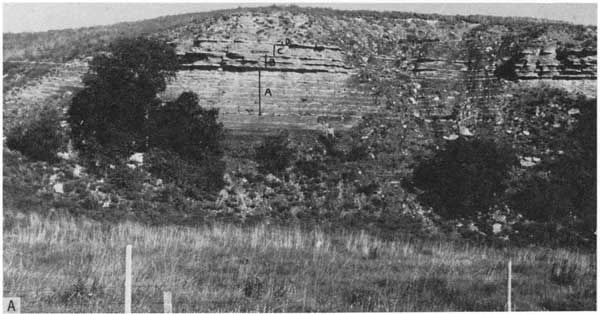

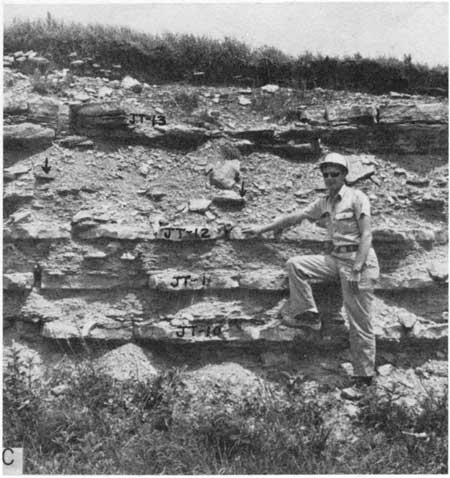
Basal submember
The nine chalky limestone beds and associated shaly chalk units which in central Kansas characterize the basal submember apparently correspond to the Flagstone horizon of Logan (1897, p. 215). This distinctive unit ranges in thickness from 6.2 feet in Cloud County (Loc. 46) to 15.6 feet in Hodgeman County (Loc. 9). At Locality 14, in Hamilton County, the exactly equivalent interval in the Bridge Creek Member is 16.6 feet thick; however, total thickness of Bridge Creek strata containing chalky limestone beds like those of the basal submember is 40.6 feet and includes lateral equivalents of the middle and upper parts of the central Kansas Hartland. The basal submember is conspicuous in the close spacing of subequally thick chalky limestone beds and their light-colored weathering. These beds are most extensively exposed in cuts along roads that cross bluffs adjacent to streams and are also exposed commonly in cliffs and along cut banks of streams as at Localities 5, 9, 10, 21, and many others. For convenience the chalky limestone beds are designated JT-1 through JT-9, respectively, and will be referred to as such hereinafter.
The shaly chalk interval between JT-6 and JT-7 is consistently thicker than that between any other two chalky limestone beds, and permits ready division of the submember into upper and lower parts (Fig. 11,A). A zone of thin-bedded chalk is developed in this thicker shaly interval at many localities and is especially obvious at Localities 9, 15, and 50 near the southwestern end of the central Kansas outcrop. At most localities the most conspicuous chalky limestone beds are JT-1 and JT-6 by reason of generally greater thickness as well as greater resistance to erosion. Bed JT-1 ranges in thickness from 0.25 to 0.4 foot, averaging 0.34 foot for 19 measurements. Bed JT-6 ranges in thickness from 0.3 to 0.6 foot, and averages 0.44 foot for 19 measurements. The other chalky limestone beds are mostly continuous, but discontinuities have been recorded locally in JT-4, JT-5, JT-8, and JT-9. Thickness of beds other than JT-1 and JT-6 ranges from zero (where discontinuous) to a maximum of 1.7 feet. The latter figure is the result of very local thickening of JT-7 at Locality 14 where normal bed thickness is 0.55 foot (see Figure 11,A). Some of the beds, including JT-4, JT-5, and JT-9, are poorly developed locally, consisting of relatively thin, burrowed chalk, rather than hard chalky limestone. Bed JT-4 exhibits this character most commonly. Most of these same beds can be recognized in the Front Range foothills of Pueblo County, Colorado, 145 miles west of Hamilton County, Kansas (see Hattin, 1971).
Fresh color of these limestones ranges from light olive gray (5Y6/1) to dark olive gray (5Y3/1) and the most common weathered colors are grayish orange, pale grayish orange, yellowish gray (5Y8/1), very pale orange, and grayish yellow. All of these beds contain numerous chalk-filled burrow structures and are mottled in consequence of these structures (Figs. 11,B,C). The mottles are most evident in the least-weathered beds and burrow fill is generally the darkest part of the rock. Highly weathered rocks are also mottled but in these the individual burrows are distinguished with difficulty. Most of the chalk-filled burrows are assignable to Planolites Nicholson. Calcite, pyrite or limonite-filled burrows, including simple tubular types and Chondrites Sternberg, are common in some beds, especially in the interval JT-1 to JT-6. These trace fossils have been illustrated elsewhere (Hattin, 1971). Dark yellowish-orange limonite stains are common in most weathered beds and are commonly concentrated around burrow structures and in the most highly burrowed parts of the beds. The central portion of some beds, especially beds JT-3, JT-6, and JT-7, is much stained by limonite in some weathered exposures, probably owing to oxidation of pyrite formed in association with burrow structures. Some of the beds contain pyrite nodules, usually near the bed centers, and where weathered these nodules have been oxidized to limonite. Such nodules have been observed in JT-1, JT-2, JT-3, JT-6, JT-7, and JT-9.
Figure 11--Stratigraphic features of the lower submember of the Jetmore and equivalent part of the Bridge Creek Member. A) Exposure of middle part of Bridge Creek Member, sec. 14, T. 23 S., R. 42 W., Hamilton County (Loc. 14) showing strata equivalent to most of lower submember beds (JT-3 to JT-10). Note thicker interval of shaly chalk separating JT-6 from JT-7 and local thickening in JT-7. B) Burrow-mottled chalky limestone from marker bed JT-3, sec. 5, T. 13 S., R. 15 W., Russell County (Loc. 25). Structures are mostly referrable to Planolites Nicholson. X1. C) Burrow-mottled chalky limestone bed (JT-7) in Bridge Creek Member, sec. 14, T. 23 S., R. 42 W., Hamilton County (Loc. 14). Note lack of stratification within bed and gradational contact, especially at base, with adjacent shaly chalk units. Cent for scale. D) Exposure of lower part of Jetmore Member, sec. 18, T. 13 S., R. 12 W., Russell County (Loc. 3), showing laminated nature of shaly chalk (surrounding cent) and laminated bed of skeletal limestone (F) composed mainly of planktonic foraminifer tests.
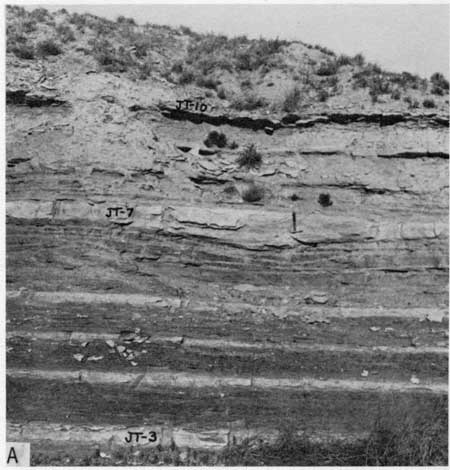
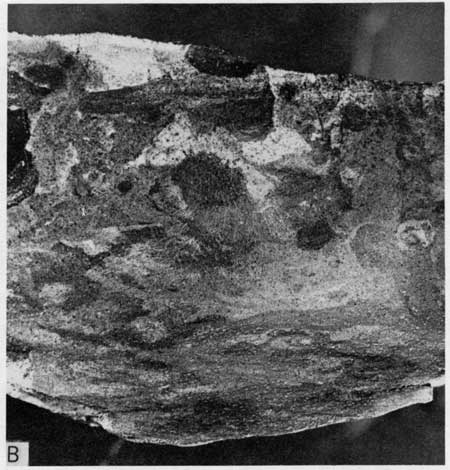
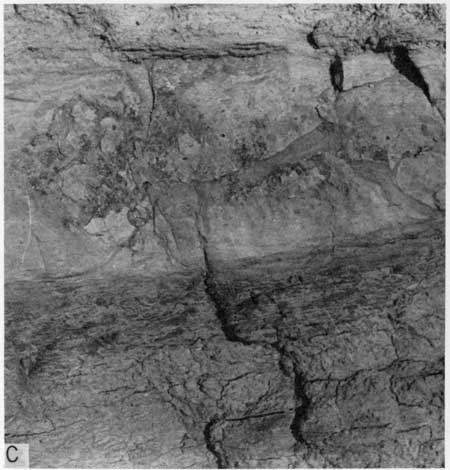
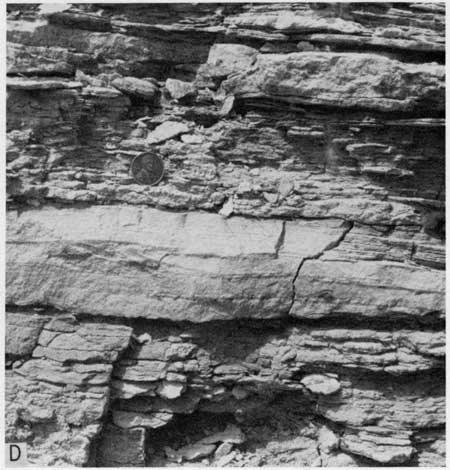
The chalky limestones are usually tough where fresh, and are hard, brittle, and commonly manifest blocky fracture where weathered. In most places the chalky limestone beds are resistant to weathering and project as ledges from eroded slopes and weathered road cuts. The beds are nearly everywhere massive, i.e., lacking laminations (Fig. 11,C). This is interpreted as the result of extensive burrowing by a highly mobile infauna. At Locality 14, a chalky limestone bed in the Bridge Creek Member, below JT-1, contains thin laminations that are truncated and destroyed locally by burrowing. Concretionary chalky limestone, so much in evidence in younger parts of the Greenhorn section, is virtually absent in the basal submember. However, where chalky limestone beds are discontinuous, e.g., JT-9 at Locality 45 (Cloud County) the bed segments take on a concretionary appearance. The Hartland equivalent of the Bridge Creek Member, which is part of the same lithofacies as the basal submember, contains concretionary chalky limestone just below marker bed HL-2 at Locality 14.
Chalky limestone layers in the basal submember tend to be uneven at top and base. Where weathered, the beds may stand out sharply from the surface, usually with well-defined upper and lower contacts, but in fresh exposures the contacts are commonly gradational, suggesting that conditions which created the beds were initiated and terminated gradually (Fig. 11,C).
The most common body fossils in these chalky limestone beds are Mytiloides labiatus and Watinoceras reesidei (Warren). The former, known from all nine beds, is usually preserved in the round, suggesting that these beds were lithified sooner than the adjacent shaly chalk beds where all such bivalves are thoroughly flattened. Specimens in the limestones retain only the calcitic prismatic layer or are preserved as molds, and occur whole or as fragments; no large concentrations of shells were observed in any bed. Watinoceras reesidei has been recorded in all beds except JT-9, but this species also occurs stratigraphically higher in the section. All of these ammonites are preserved as molds and most are preserved in-the-round, but many have suffered a little flattening by compaction. The largest concentrations of W. reesidei are in beds JT-1 and JT-6; specimens were collected in greatest numbers at Locality 43 (Rush County) in bed JT-1. Other fossils in the nine chalky limestone beds include Mammites nodosoides subsp. wingi Morrow, occurring mostly in JT-6 but also in JT-2 and JT-8, Baculites cf. B. yokoyamai Tokunaga and Shimizu which apparently ranges throughout the submember, Tragodesmoceras bassi (JT-8); Pycnodonte sp. A (JT-8), sparse unidentified ostreids (JT-1, JT-2) and rare specimens Discinisca sp. and Anomia sp. A. At Locality 14 nine Bridge Creek beds that are equivalent to the basal submember of central Kansas have Mytiloides labiatus (all beds); Vasoceras birchbyi (JT1); Baculites cf. B. yokoyamai (JT-4, 6, and 9); W. reesidei (JT- 1); Discinisca sp. (JT-3, 5, and 7); Anomia sp. A (JT-4 and 6); and Mammites nodosoides wingi (JT-6). At Locality 14 the following additional species occurrences have been reported by Cobban and Scott (1972, p. 21); Neoptychites cf. N. cephalotus (Courtiller (JT-1), T. bassi (JT-7 and JT-9) and Baculites cf. B. yokoyamai (JT-2 and JT-7).
Shaly chalk beds in the basal submember and in equivalent and older Bridge Creek strata, are essentially like those of the Hartland Member. Predominant color of the fresh rocks is dark olive gray (5Y3/1) to olive black and weathered rock exhibits a wide range of colors including light olive gray (5Y6/1, 5Y5/2), yellowish gray (5Y8/1, 5Y7/2), medium yellowish brown (10YR5/2) and grayish orange. Weathered rocks are commonly stained yellowish orange along joints and bedding surfaces. The rock is tough and breaks blocky where fresh, and is soft and flaky where weathered. Like other shaly chalk units these are nearly everywhere speckled by minute nearly white, oblate spheroidal fecal pellets and contain much calcareous silt and fine sand. All of the shaly chalk is laminated (Figs. 11,D; 12,A), but that near the base of the submember tends to be more thinly and evenly laminated than that near the top (Fig. 12,B). The laminae tend toward obliteration in extensively weathered exposures. In the part of the Bridge Creek Member representing the lower submember of the jetmore some shaly chalk units contain one or more very thin scams of selenite; a few of these are limonitic. These may represent the position of thin films of bentonite. In the interval between marker beds JT-1 and JT-10 measured thickness of the shaly chalk beds ranges from a minimum of 0.45 feet between JT-3 and JT-4 and between JT-4 and JT-5 (Loc. 20) to a maximum of 3.15 feet between JT-6 and JT-7 in the Bridge Creek Member at Locality 14.
Figure 12--Stratigraphic features of the Jetmore Member and equivalent part of Bridge Creek Member. A) Shaly chalk specimen from between JT-2 and JT-3, cut normal to bedding, showing thin laminations characteristic of lower part of basal submember, sec. 18, T. 13 S., R. 12 W., Russell County (Loc. 3). X1. B) Shaly chalk specimen from between JT-7 and JT-8, cut normal to bedding, showing imperfectly laminated rock from upper part of basal submember, sec. 27, T. 6 S., R. 9 W., Mitchell County (Loc. 1). Light-colored grains are foraminifera. Light-colored, lensing laminae are composed mostly of foraminifera. X1. C) Exposure of "hard beds" submember, sec. 14, T. 23 S., R. 42 W., Hamilton County (Loc. 14). This locality is 230 miles from the exposure illustrated in Figure 10, C. Note tendency of these beds to fracture roughly parallel to bedding. D) Upper surface of limestone slab (float) from one of three "hard beds," sec. 18, T. 8 S., R. 3 W., Cloud County (Loc. 46), showing little-flattened molds of Inoceramus (Mytiloides) labiatus. X1/2.
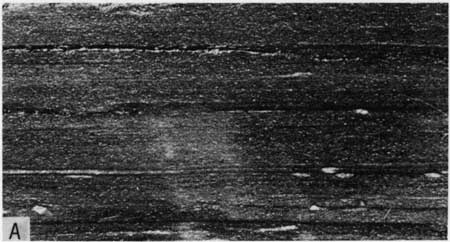
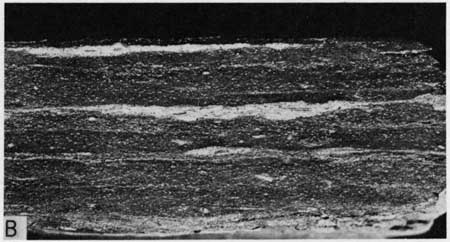
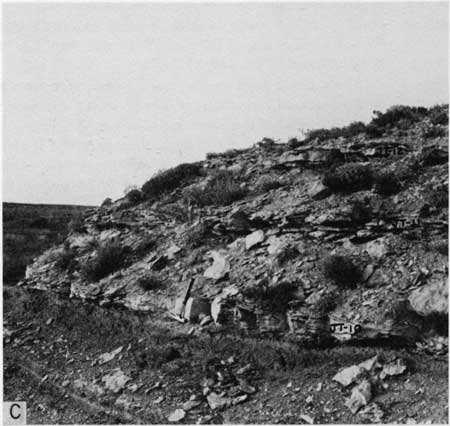
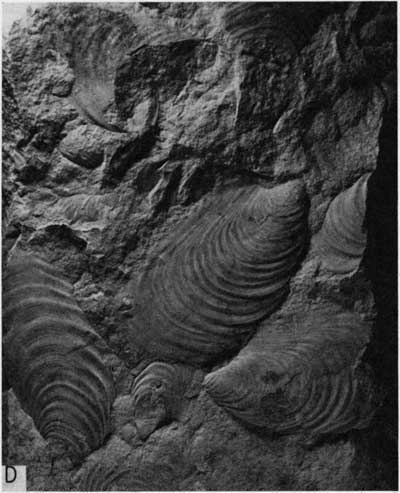
In these shaly chalk beds Mytiloides labiatus is ubiquitous, occurring as fragments and as whole shells lying parallel to bedding and thoroughly flattened by compaction. In nearly every locality studied, shaly chalks above JT-8, and locally also between JT-7 and JT-8, are crowded with shells, shell fragments, and lenses of shell fragments of M. labiatus. These project conspicuously from weathered surfaces, thus marking a pronounced change from environmental conditions represented by the underlying beds. Clusters of the oyster Pycnodonte sp. A are commonly attached to the valves of Mytiloides labiatus in these shell-crowded beds, especially in that lying above JT-9. Planktonic foraminifera are also ubiquitous in the shaly chalk beds, and cause textural roughness where sufficiently abundant to stud the bedding surfaces. Very thin, wafer-like lenses of foraminiferal limestone were recorded in shaly chalks between JT-1 and JT-3, and some lenses rich in forams occur also in the Mytiloides-crowded beds above JT-7 (see Fig. 12,B). Fish scales, bones, and a few teeth are scattered through shaly chalk beds in the lower submember. Sparse burrow structures, although more characteristic of the chalky limestone beds, have been recorded in shaly chalk of the basal submember at a few localities.
In most Kansas exposures a discontinuous, lensing layer of foraminiferal limestone lies in the shaly chalk that separates marker beds JT-1 and JT-2 (Fig. 10,B). At Localities 10 and 20 the basal 0.5 and 0.2 foot, respectively, of the shaly chalk unit contains several very thin lenses of foraminiferal limestone any one or all of which may represent the foram bed of other localities. At Localities 4 and 15 the foraminiferal limestone is apparently absent. The foram bed lies anywhere from 0.25 to 0.5 foot above the top of JT-1. Color is olive gray where fresh and grayish orange and very pale orange to very pale yellowish brown where weathered. The bed is thinly laminated (Fig. 11,D), and locally cross laminated. At Locality 3 the cross laminae dip 7° to 15° in a N 10° E direction. This is in general correspondence with current data for skeletal limestones in the lower part of the Lincoln Member (see above). Foram-filled burrow structures of the Planolites type up to 13 mm in diameter were recorded in this bed of Localities 45, 48 and 68.
Very thin (0.01-foot-thick) bentonite seams were observed a short distance above JT-2 at Localities 14 and 50; otherwise this submember apparently lacks bentonite.
Hard Beds
Because of greater resistance to the hammer and to erosion I refer to limestones of the second submember of the Jetmore as the "hard beds" (Figs. 10,C; 12,C). In Hamilton County (Loc. 14) these beds are included in the Bridge Creek Member. Thickness of this interval ranges from 2.6 feet (Locality 20, Jewell County) to 4.0 feet (Locality 14, Hamilton County) averaging 3.1 feet for 20 measurements. For convenience the three limestone marker beds in this submember are designated (ascending) JT-10, JT-11, and JT-12. Thickness of these beds is as follows:
| Bed | Thickness, range, feet |
Average thickness, feet |
No. of measurements |
|---|---|---|---|
| JT-10 | 0.25 to 0.55 | 0.41 | 19 |
| JT-11 | 0.2 to 0.6 | 0.36 | 19 |
| JT-12 | 0.2 to 0.45 | 0.36 | 19 |
Where least weathered the color of these beds is dark olive gray (5Y3/1) to light olive gray (5Y6/1, 5Y5/2) or yellowish gray (5Y7/2). Weathered beds are pale grayish yellow, grayish orange, or pale grayish orange. At most places these limestones are harder, and more brittle than adjacent chalky limestone beds and during weathering tend to shatter more or less parallel to the bedding (Fig. 12,C). Upper and lower surfaces of the beds are generally undulatory. All of the beds contain burrow structures and these are most abundant in JT-10 but these limestone beds are not as extensively burrowed as beds JT-1 through JT-9. The burrows are of two major kinds including large irregularly meandering chalk-filled structures assignable to Planolites and slender (2 to 4 mm diameter) smooth-walled straight to slightly sinuous structures filled with phanerocrystalline calcite or, less commonly, pyrite. The second type may be oriented at any angle to the bedding.
At all localities examined the three limestones contain abundant disarticulated valves and valve fragments of Mytiloides labiatus. No definitely articulated valves were observed during this study. In contrast to specimens preserved in the adjacent shaly chalk beds the valves of this clam are not much flattened by compaction (Fig. 12,D). A few lie at angles to the bedding but the vast majority are parallel to the general stratification. A few specimens bear attachment scars of a large, nearly circular, thin-shelled pelecypod that is probably Pycnodonte sp. A. At Locality 3 shell fragments 3 to 4 mm in thickness indicate that some specimens of M. labiatus reached large size and at Locality 46 one broken specimen was found to be 26 cm high. Two one-meter-long taut-line counts of M. labiatus were made on a float slab from one of the hard beds at Locality 6, with counts of 13 and 25 specimens respectively. Two parallel, meter-long counts on bed JT-12 at Locality 46 yielded 5 and 10 specimens, respectively. These limited data give some appreciation of the great abundance of clams in these limestone beds. Valve orientation was measured at two localities with the following results:
| convex up | concave up | |
|---|---|---|
| Loc. 3, JT-10 | 16 | 15 |
| Loc. 3, JT-11 | 10 | 35 |
| Loc. 3, JT-12 | 18 | 45 |
| Loc. 46, JT-10 | 18 | 23 |
| Loc. 46, JT-11 | 31 | 19 |
| Loc. 46, JT-12 | 14 | 33 |
| Loc. 46, float | 24 | 59 |
These data suggest either that the valves have suffered little transport, or that the concave up position is the more stable. The former interpretation is regarded as the more likely.
Other fossils in the hard beds include Baculites cf. B. yokoyamai, which is better preserved here than in other parts of Jetmore, molds of a smooth baculitid that may be imperfectly preserved B. cf. B. yokoyamai, sparse oysters (probably Pycnodonte sp. A), and rare specimens of Tragodesmoceras bassi (Locality 66), Mammites nodosoides wingi (Locs. 46 and 65), and Watinoceras reesidei (Locality 35). Specimen abundance was measured in two 1/4-meter areas on bed JT-10 at Locality 3, with the following results:
| Area 1 | |
|---|---|
| Mytiloides labiatus | 30 |
| Baculites cf. B. yokoyamai | 1 |
| Burrow cast | 1 |
| Mytiloides, small fragments | several |
| Area 2 | |
| Mytiloides labiatus | 79 |
| Baculites cf. B. yokoyamai | 1 |
| Mytiloides, small fragments | several |
The two shaly chalk beds separating the three hard limestone beds of the second submember are usually seen in a weathered condition because so many of the best exposures are in topographically high parts of the outcrop. The unweathered rock is olive black or dark olive gray (5Y3/1); color of the weathered rock is light gray and yellowish gray to pale yellowish brown and grayish orange. Dark yellowish-orange limonite stains are common in weathered exposures. Like other shaly chalk units these beds are speckled by nearly white fecal pellets, contain much calcareous silt and fine sand (mostly foraminifera and inoceramid prisms), and are thinly laminated. Extensive weathering has virtually obliterated the laminations locally and abundance of skeletal debris and lenses of skeletal limestone cause the laminations to be less obvious than in older parts of the section. These two shaly chalk units contain abundant shells and shell fragments of Mytiloides labiatus which project conspicuously at the surface and litter the slope of weathered exposures. Some of the specimens of M. labiatus reached exceptionally large size. Thin lenses of inoceramite and lenses consisting of stacked valves or valve fragments of Mytiloides are common in the shaly chalk. Both shaly chalk units locally contain irregular zones of shell-rich chalky limestone wherever abundant Mytiloides remains have been tightly welded together in a chalk matrix. At Localities 1 and 20 the upper shaly chalk unit contains a layer of chalky limestone concretions that are filled with remains of Mytiloides. In addition to M. labiatus these beds have also yielded specimens of Pycnodonte sp. A. The last are attached to M. labiatus, usually in clusters, and in some places two generations of oysters are represented.
At all localities examined marker bed JT-10 is overlain directly by a thin to very thin seam of bentonite. In most of central Kansas the bentonite is 0.02 foot or less in thickness and is commonly discontinuous within a single exposure. In the Bridge Creek Member of Hamilton County (Loc. 14) the seam is 0.14 foot thick. This bentonite can be identified also in Cimarron County, New Mexico (Kauffman, Hattin, and Powell, in preparation) and in Pueblo County, Colorado (Hattin, 1971) where its association with the lowermost hard limestone bed containing abundant Mytiloides labiatus is unmistakable. In Kansas the bentonite is olive gray in rare fresh exposures, light olive gray (5Y6/1) to very light gray in partially weathered exposures, and, most commonly, dark yellowish orange where stained by limonite in much-weathered exposures.
Third Submember
The third submember of the Jetmore includes strata lying between marker beds JT-12 and JT-13 (Shellrock limestone bed). This interval is composed mostly of shaly chalk and averages 2.66 feet in thickness for 20 measurements, including Locality 14 (Hamilton County) where these strata are included in the Bridge Creek Member. The shaly chalk is dark olive gray (5Y3/1) to olive black in sparse, unweathered exposures and yellowish gray (5Y7/2) to grayish orange or pale grayish orange (10YR8/4) in weathered exposures. The rock is at least in part thinly laminated, contains much calcareous silt and fine sand (mostly foraminifera and inoceramid prisms), and is speckled by nearly white, oblate spheroidal fecal pellets. The last are difficult to detect in weathered rocks. At all exposures studied shaly chalk in this stratigraphic interval contains an abundance of whole and broken valves of Mytiloides. Small lenses of skeletal limestone, consisting of stacked, imbricated, or irregularly arranged Mytiloides fragments, as well as prisms, are common in this interval, especially in the lower part. Mytiloides valves and fragments and lenses of skeletal limestone project conspicuously from weathered slopes and litter the eroded surface (Fig. 13,A). In this submember lamination of shaly chalk is best developed where abundance of Mytiloides remains is least. The shaly chalk usually grades into the overlying Shellrock limestone bed through 0.55 foot or less of very thin bedded chalk.
Figure 13--Stratigraphic features of the upper part of the Jetmore Member and equivalent part of Bridge Creek Member. A) Weathered surface of shaly chalk between JT-12 and JT-13, sec. 18, T. 8 S., R. 3 W., Cloud County (Loc. 46), showing characteristic abundance of Inoceramus fragments. Cent for scale. B) Single bed of irregular-shaped, lens-like bodies of shell-rich limestone in part of Bridge Creek Member that is equivalent to the third submember of the Jetmore, sec. 14, T. 23 S., R. 42 W., Hamilton County (Loc. 14). Laminae of adjacent shaly chalk arch above and bend beneath the concretionary masses of limestone. C) Exposure of Shellrock limestone, sec. 28, T. 15 S., R. 17 W., Ellis County, showing oblate-spheroidal concretions in upper part of bed. D) View, normal to bedding, of central part of Shellrock limestone bed, sec. 18, T. 8 S., R. 3 W., Cloud County (Loc. 46), showing abundant whole valves of Inoceramus (Mytiloides) labiatus. Cent for scale.
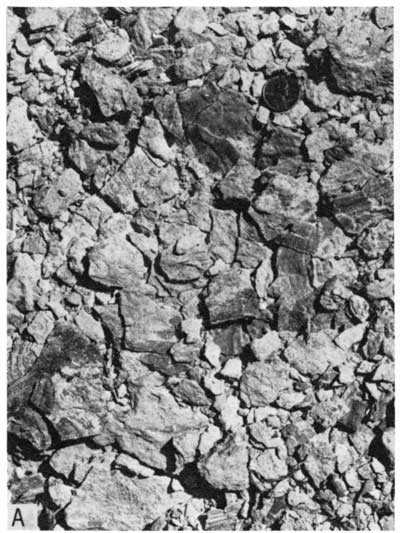
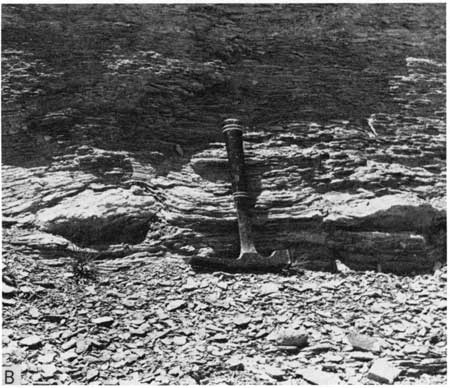
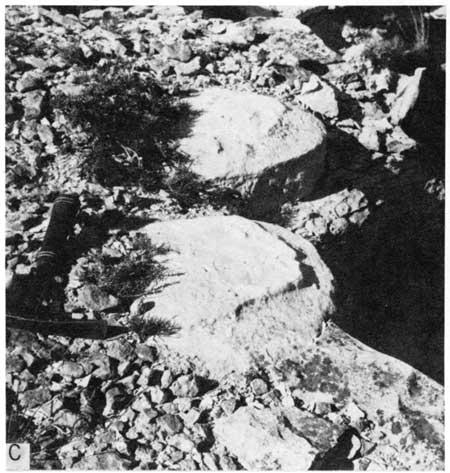
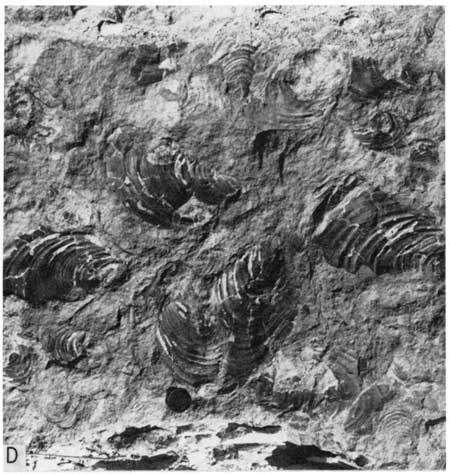
The shaly chalk interval separating the uppermost hard bed (JT-12) from the Shellrock limestone bed (JT-13) contains from one to three beds of chalky limestone (Fig. 10,C). At most localities examined there are two such beds, at two localities only one was observed, and at two localities three beds were recorded. At all localities where two beds are exposed, the lower bed is discontinuous, consisting of mostly irregular-shaped concretionary bodies that are rich in whole and fragmentary valves of Mytiloides labiatus; this limestone is lithologically similar to that of the three hard beds although not everywhere as hard and brittle, and reaches maximum thickness of 0.3 foot. The upper bed lies at or just above the middle of the third submember and consists of concretionary chalky limestone that is sparingly fossiliferous and generally softer than that below. At three localities (3, 4, 20) the upper layer is thin (0.1 to 0.2 foot thick), flat at top and base, and continuous across the respective exposures, but at all other places consists of smooth-surfaced oblate spheroidal concretions ranging from 0.18 to 0.3 foot in thickness. The origin of these structures is manifest not only in their shape but in the preservation within them, at several localities, of thin laminations similar to those in the surrounding shaly chalk. At some localities the upper bed contains fairly common specimens of Baculites cf. B. yokoyamai and Anomia sp. A.
At localities where only one of these limestone beds is present between JT-12 and JT-13, as at Localities 14 and 15, it is the lower, discontinuous, shell-rich bed that lies in the lower half of the interval (Figs. 2,D; 13,B). Where more than two beds are present, as at Localities 6, 20, and 68, the additional bed is in the lower half of the interval and is lithologically and paleontologically similar to the lower, discontinuous, shell-rich bed of chalky limestone. These chalky limestones are usually speckled by nearly white spheroidal pellets, like those in adjacent shaly chalk. In most sections studied the limestones are weathered, with grayish orange, pale grayish orange (10YR8/4) and yellowish gray (5Y7/2, 5Y8/1) colors prevailing. Where least weathered the lower, shell-rich concretionary bed is olive gray (5Y4/1) and the layer of oblate spheroidal concretions is medium gray. Both kinds of limestone project conspicuously from weathered slopes. Adjacent layers of shaly chalk generally arch above and bend beneath these limestone bodies, suggesting that lithification was well advanced prior to final compaction of the shaly chalk (Fig. 13,B).
These chalky limestones are identical, respectively, to the irregular, discontinuous, shell-rich, concretionary beds and layers of oblate spheroidal concretions that characterize the Pfeifer Member; furthermore, the Shellrock limestone bed, which overlies the third submember, is not only concretionary in its upper part but also lithologically more like beds of chalky limestone in the Pfeifer than like the limestones in Jetmore beds JT-1 through JT-12. Jetmore strata above JT-12 are related genetically to the Pfeifer and should be reclassified as a part of the Pfeifer Member (Hattin, 1968a).
Shellrock limestone bed
The fourth submember of the Jetmore, designated JT-13 on Plate 1, and known informally as the Shellrock limestone bed, comprises a relatively hard, resistant chalky limestone unit that can be traced across the entire Greenhorn outcrop of Kansas. The Shellrock is a prominent benchmaker (Fig. 2,C) and underlies the upland surface directly at a number of places. Thickness of the Shellrock bed ranges from 0.9 (Locs. 14, 48) to 1.35 feet (Loc. 20), averaging 1.1 feet for 20 measurements. At some localities this unit comprises a single massive bed containing no partings, and having homogeneous lithology. At other localities one or more bedding fractures are developed, probably in response to weathering (Fig. 10,C). The center of the unit is very thin bedded at Locality 6; the lower part is very thin bedded, and more or less transitional with the underlying shaly chalk at Localities 9, 14, and 20. In central Kansas the upper part of the unit is generally concretionary although this feature is not evident at every locality. Concretionary structure ranges from oblate hemispheroidal bulges on the upper surface of the Shellrock bed to well-defined oblate spheroidal concretions (Fig. 13,C). At Locality 6 concretionary rock forms most of the upper surface, depressions between concretionary areas resembling the button areas of a sofa pillow. At Locality 20 an oblate spheroidal concretion was recorded in very thin bedded chalky limestone at the base of the Shellrock unit. Where least weathered the Shellrock bed is olive gray. In most exposures the rock exhibits weathered coloration that ranges from yellowish gray (5Y8/1, 5Y7/2) to grayish orange or pale grayish orange (10YR8/4). Dark yellowish orange limonite stains are common. The rock is generally speckled throughout by nearly white spheroidal fecal pellets.
Except for concretionary rock at the top of the Shellrock, the bed usually is crowded with whole shells and fragments of Mytiloides labiatus (Fig. 13,D). These are usually more concentrated near the middle or in the lower half of the unit. The shells are nearly all arranged parallel to bedding and virtually all are disarticulated. Most specimens retain some of the original convexity; orientation is mostly concave down. Sparry calcite-filled sheltered voids were observed beneath valves of Inoceramus at Locality 50. Meter-long taut-line counts of whole valves on bed surfaces were made at three localities with the following results:
- Loc. 3, 1st count: 11, 2nd count: 9
- Loc. 5, 1st count: 10, 2nd count: 13
- Loc. 6, 1st count: 6, 2nd count: 7
- Loc. 6, 1st count: 19, 2nd count: 17
Baculites cf. B. yokoyamai, usually consisting of flattened molds, but locally of crystalline calcite, is common on the non-concretionary upper surface of the unit. Compass bearings were recorded for orientation of 44 baculitid molds at the top of the Shellrock at Locality 4. These were plotted as a rose diagram; no preferred orientation was detected. Coiled aminonites are very rare in the Shellrock bed; fragmentary specimens of Mammites nodosoides wingi (Localities 46 and 50), unidentified ammonite molds (Localities 44 and 46), and Stomohamites cf. S. simplex (Locality 46) are the only non-baculitid specimens I discovered. Chalk-filled and rare calcite-filled burrow structures are preserved in the Shellrock at a few localities, the former are especially common on a bedding surface in the middle of the unit at Locality 63 where maximum observed width of randomly branching thalassinoid burrows is approximately 1.5 cm. Pseudoperna bentonensis was observed in the Shellrock at Localities 5 and 50. At Locality 5 these oysters were encrusted on the interior surface of a Mytiloides valve. Anomia sp. A was recorded from the unit at Locality 50 and a large petrified log was recorded in the bed at Locality 10.
Macroinvertebrate Fossils
As noted above, the biostratigraphic zonation of the Greenhorn is treated in a separate part of this report and is not based on all of the macroinvertebrate species. The following list includes all macroinvertebrates recorded in Jetmore and equivalent Bridge Creek strata during the present study. Inclusion of a taxon in this list does not indicate co-occurrence with all the other species. Common forms are preceded by an asterisk. Rare forms, or those known from only one locality, are preceded by a dagger.
| Brachiopods: | |
| †Discinisca | |
| Bivalves: | |
| Anomia sp. A | |
| *Inoceramus (Mytiloides) labiatus (Schlotheim) | |
| †Pseudoperna bentonensis (Logan) | |
| *Pycnodonte sp. A | |
| *Teredolithus sp. | |
| Cephalopods: | |
| ammonite molds, unidentified | |
| *Baculites cf. B. yokoyamai Tokunaga & Shimizu | |
| *Mammites nodosoides (Schlotheim) subsp. wingi Morrow | |
| Mammites sp. (fragments) | |
| †Stomohamites cf. S. simplex (d'Orbigny) | |
| †Tragodesmoceras bassi Morrow | |
| †Vascoceras birchbyi Cobban & Scott | |
| *Watinoceras reesidei Warren | |
| Cirripeds: | |
| †acrothoracian borings (in Mytiloides valve) | |
| †scalpellid, sp. (undescribed) | |
The Jetmore species identified as Pseudaspidoceras cornucostale by Morrow (1935, p. 469) was not recorded during the course of my study. Jetmore macroinvertebrate fossils are illustrated in Plates 7, 8, and 9.
Explanation of Plate 7
Bivalves from the Jetmore Member
A-G, Mytiloides labiatus (Schlotheim): A, internal mold of right valve, X1, KU82160, middle part of Jetmore Member at Locality 6; B, internal mold of right valve, not coated, X1, KU82159, middle part of Jetmore Member at Locality 38; C, internal mold of left valve, X1, KU82162, basal bed of Jetmore equivalent of Bridge Creek Member at Locality 14; D, internal mold of right valve, X1/2, KU82165, middle part of Jetmore Member at Locality 46; E, internal mold of right valve, X1, KU82163, lower part of Jetmore Member at Locality 38; F, internal mold of right valve, X1, KU82161, middle part of Jetmore Member at Locality 4; G, internal mold of right valve, X1, KU82164, middle part of Jetmore Member at Locality 28.

Explanation of Plate 8
Mollusks and a brachiopod from the Jetmore Member
A,E, Pycnodonte sp. A: A, view of two articulated specimens, X2, KU82166, middle part of Jetmore Member at Locality 38; E, cluster of articulated valves, X1, KU82167, middle part of Jetmore Member at Locality 38.
B, Anomia sp. A: left valve, X2, KU82169, uppermost bed of Jetmore Member at Locality 50.
C, Discinisca sp.: largely exfoliated brachial valve, X2, KU82158, middle part of Jetmore Member at Locality 50.
D,I,J, Watinoceras reesidei Warren: D, latex cast of external mold, X1, KU82150, basal bed of Jetmore Member at Locality 66; I, internal mold, X2, KU82148, basal bed of Jetmore Member at Locality 43; J, latex cast of external mold, X1, KU82149, middle part of Jetmore Member at Locality 35.
F,G,H, Baculites cf. B. yokoyamai Tokunaga & Shizimu: F,G, internal molds, both X1, KU82168, KU82154, lower part of Jetmore Member at Locality 38; H, internal mold, X1, KU82155, middle part of Jetmore Member at Locality 28.
K,L,M, Mammites nodosoides wingi (Morrow): K,L, lateral and ventral views of internal mold fragment, X1/2, KU82157, lower part of Jetmore Member at Locality 20; M, ventral view of internal mold fragment, X1/2, KU82156, middle part of Jetmore Member at Locality 6.
N, Vascoceras birchbyi Cobban & Scott: lateral view of incomplete internal mold X1, KU82142 basal bed of Jetmore equivalent of Bridge Creek Member at Locality 14.

Explanation of Plate 9
Ammonites from the Jetmore Member
A,B,C,E, Tragodesmoceras bassi Morrow: A, internal mold, X1, specimen from Fort Hays Kansas State College collection, 11847, probably from one of the three hard beds of the Jetmore Member. Locality unknown; B, combination of internal and external mold, X1, KU82146, middle part of Jetmore Member at Locality 66; C, flattened internal mold, X1, KU82144, middle part of Jetmore Member at Locality 67; E, latex cast of external mold, X1, KU82145, middle part of Jetmore Member at Locality 28.
D, Vascoceras birchbyi Cobban & Scott, fragment of internal mold, X1/2, KU82143, basal bed of Jetmore equivalent of Bridge Creek Member at Locality 14.
F,G, Watinoceras reesidei Warren: F, latex cast of external mold, X1, KU82147, lower part of Jetmore Member at Locality 20; G, internal mold, X1, KU82151, float from lower part of Jetmore Member at Locality 1.

Brachial valves of 7 specimens of Discinisca were recovered from the Jetmore Member. In chalky limestones these are preserved as skeletal material preserving the original luster or as molds. A single specimen from shaly chalk is a valve from which most of the inorganic matter has been leached. Specimens of Anomia are preserved as calcitic valves and many preserve the original pearly luster. Most specimens of Inoceramus retain the calcitic prismatic layer; the aragonitic nacreous layer is nowhere preserved. A few specimens in weathered chalky limestone occur as molds and these commonly are heavily stained by limonite, especially those from the three hard beds (JT-10, 11, and 12). Pycnodonte and Pseudoperna are preserved mostly as calcitic valves that are usually attached to valves of Mytiloides but are found also as isolated, disarticulated valves. Teredolithus occurs as limestone molds of original tubes having bulblike terminations. A single, large cluster of calcitic Teredolithus, originally in wood of which almost no trace remains, was collected as float from either JT-10, 11, or 12 at Locality 28. Regardless of lithology, Jetmore and Bridge Creek cephalopods nowhere are preserved as original skeletal material. All are molds in chalky limestone except for a few baculitids which are lined or filled with visibly crystalline calcite. Sparse, disarticulated plates of a scalpellid are preserved as calcite that is probably little altered.
Pfeifer Shale Member
General Description
The Pfeifer Shale Member of the Greenhorn was named by Bass (1926, p. 32) for exposures near the town of Pfeifer (Pi'fer), Ellis County, Kansas. The Pfeifer is well exposed here in bluffs that rise above the north side of Smoky Hill River. According to Bass a measured section of the Pfeifer in SE sec. 21, T. 15 S., R. 17 W. is 18 feet 11 inches in thickness and the member ranges from 19 to 21 feet in the County. At Locality 5, 2.5 miles west northwest of Pfeifer, I found the Pfeifer to be 19.8 feet in thickness. The member includes strata lying between the Shellrock limestone bed (JT-13) and the top of the Fencepost limestone bed and is composed primarily of shaly rock through which are scattered continuous beds; irregular, discontinuous, shell-rich, concretionary beds; or layers of oblate spheroidal concretions of chalky limestone. In Hamilton County the member was included by Bass (1926, p. 69) in the more embracive Bridge Creek Limestone Member of the Greenhorn, but the exact equivalent of the Pfeifer is readily recognizable there (see Plate 1). The Pfeifer member has received formal recognition only in Kansas where the thickness ranges from 15.2 (Loc. 1) to 25.8 feet (Loc. 14, Pfeifer equivalent in Bridge Creek Member) generally thickening from NE to SW, and averaging 19.72 feet for 14 measurements.
The most characteristic feature of the Pfeifer is the rich content of discontinuous beds of shell-rich concretionary limestone and layers of chalky limestone concretions. Such rocks are a common feature of the carbonate section beginning above bed JT-12 in the Jetmore Member and continuing upward in the section to a position between marker beds 2 and 3 of the Fairport Member of the Carlile Shale (see Hattin, 1962). Because the upper and lower contacts of the Pfeifer were defined arbitrarily in earlier reports, rather than on objective lithologic criteria, I believe that the Pfeifer should be redefined so as to include the section extending from the top of JT-12 to the top of Fairport marker bed number 2. As thus redefined the Pfeifer would include all of the stratigraphic interval that contains numerous irregular, discontinuous beds of concretionary limestone and/or layers of oblate spheroidal limestone concretions, and would incorporate the Shellrock limestone bed and Fairport marker bed number 2, both of which are lithologically comparable to the Fencepost limestone bed, within the framework of the member. Such revision is in accord with lithostratigraphic classification at member rank as explicitly advanced by the American Commission on Stratigraphic Nomenclature (1970, p. 7) who state "A member is established when it is advantageous to recognize a specially developed part of a varied formation" (italics mine). [Note: The Stratigraphic Names Committee of the Kansas Geological Survey does not agree that this change is warranted at present.] The classification of the part of the carbonate section that includes abundant concretionary masses of chalky limestone as parts of three members belonging to two formations simply is not in accord with accepted stratigraphic practice.
The Pfeifer contains three widely traceable marker units that can be recognized throughout the Kansas outcrop. For convenience these are designated PF-1 (Fig. 14,A), PF-2 (Fig. 4,B), and PF-3 (Fig. 4,B,C,D; 5,C,D) and consist, respectively, of an unnamed bed of chalky limestone that everywhere directly overlies a thin seam of bentonite, a bentonite and granular-calcite unit known as the sugar sand, and the Fencepost limestone bed (see Pl. 1). The member contains three other widely traceable marker beds. Two of these are bentonite seams which can be identified positively throughout central Kansas. These seams lie close to the sugar sand and Fencepost bed, respectively, and cannot be recognized on their own merits. The third is a thin flat bed of chalky limestone lying less than a foot above the sugar sand and has been observed at all but a few central Kansas exposures. Marker beds PF-1 and PF-3 are readily identified in the Pfeifer equivalent of the Bridge Creek in Hamilton County (Loc. 14), and the identification of PF-2 is reasonably certain. Of the remaining three, noncoded markers, only one, a bentonite seam lying shortly below the Fencepost bed, can be recognized at Locality 14.
Shaly Chalk
The dominant lithology in the Pfeifer Member and equivalent part of the Bridge Creek Member (Loc. 14), is shaly chalk. For practical purposes the shaly chalk may be divided into three, rather embracive units, including the intervals from top of JT-13 to PF-1, from top of PF-1 to PF-2, and from top of PF-2 to PF-3 (Fencepost limestone bed). The lowest of these intervals ranges from 4.5 (Loc. 20) to 8.3 feet (Loc. 18), averaging 6.6 feet for 17 measurements. The second interval ranges from 5.3 (Loc. 10) to 11.8 feet (Loc. 14), averaging 6.6 feet for 17 measurements. The third interval of shaly chalk ranges in thickness from 3.8 (Loc. 20) to 5.9 (Loc. 5) feet, averaging 4.8 feet for 14 measurements.
Because of the superior resistance to erosion of the Fencepost limestone bed the Pfeifer Member is exposed most commonly in the upper parts of slopes and bluffs held up by that marker. In consequence the better exposures are generally much weathered. Where fresh the shaly chalk is olive black or dark olive gray (5Y3/1) and where partly weathered the color is light olive gray (5Y6/1, 5Y5/2) or, less commonly, light to very light gray. Extensively weathered rock is mostly grayish orange to pale grayish orange (10YR8/4) or, less commonly, yellowish gray (5Y8/1, 5Y7/2) and various pale shades of brown. Such weathered rock is commonly stained dark yellowish orange by limonite, especially along fractures. The fresh rock is tough and breaks blocky; weathered rock is soft and crumbly.
Figure 14--Stratigraphic features of Pfeifer Member and equivalent part of Bridge Creek Member. A) Exposure of Pfeifer Member, sec. 18, T. 13 S., R. 12 W., Russell County (Loc. 3), showing marker bed PF-1. B) Exposure of Pfeifer equivalent of Bridge Creek Member, sec. 14, T. 23 S., R. 42 W., Hamilton County (Loc. 14), showing laminated character of shaly chalk. Slabby weathering bed (arrow) is Fencepost limestone. C) Exposure of upper part of Pfeifer Member, sec. 3, T. 13 S., R. 11 W., Russell County (Loc. 28), showing nearly continuous bed of coalescent chalky limestone concretions. D) Chalky limestone concretion from upper part of Pfeifer Member, sec. 3, T. 13 S., R. 11 W., Russell County (Loc. 28), showing extraordinarily large specimen of Inoceramus cuvieri that apparently served as a nucleus for concretion develop- ment. Cent for scale.
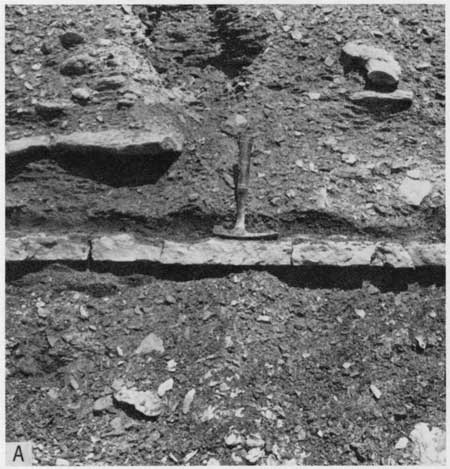
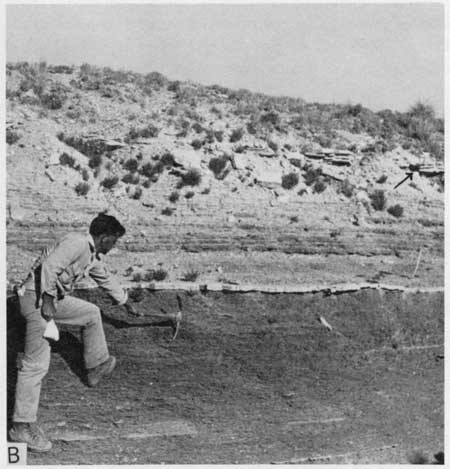
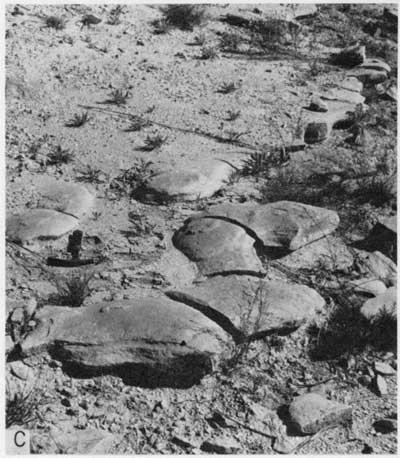
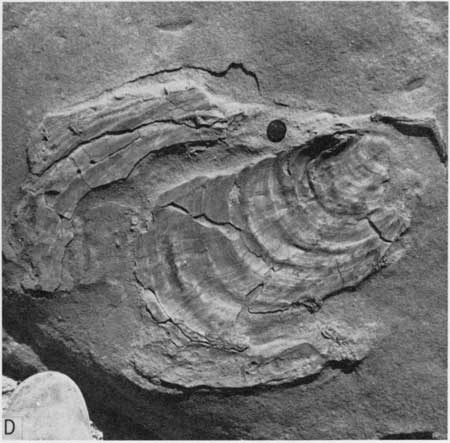
Shaly chalk units contain much calcareous silt and/or fine sand, much of which is tests of planktonic foraminifera and inoceramid prisms. The rock is generally speckled throughout by minute, nearly white, spheroidal fecal pellets although these are usually difficult to detect in highly weathered samples. Most of the rock is thinly laminated (Fig. 14,B) but especially below the sugar sand (PF-2) the laminations are commonly made uneven because the rock there contains a profusion of inoceramid fragments and small lenses of skeletal limestone. In addition to this skeletal debris shaly chalk below PF-2 usually contains numerous irregular and discontinuous beds of concretionary, shell-rich chalky limestone, and a few oblate spheroidal concretions of chalky limestone that are deficient in macroinvertebrate remains. Between marker bed PF-2 and the Fencepost bed (PF-3) the shaly chalk section is characterized by its content of oblate spheroidal concretions of chalky limestone, and does not contain an abundance of shell fragments or skeletal limestone; furthermore, shell-rich concretionary limestone is lacking in this interval at nearly all exposures examined.
In an interval extending from the base of the Pfeifer to within a foot of the sugar sand (marker bed PF-2) the shaly chalk is characterized by a profusion of inoceramid valves and valve fragments and by small, mostly very thin lenses of skeletal limestone or chalky skeletal limestone. At one extreme these lenses consist of stacked or imbricated fragments of inoceramid valves; at the other they consist wholly of inoceramid prisms and/or tests of planktonic foraminifera. In general the finer grained lenses are very thin usually less than 0.01 foot in thickness. Such rocks have a chalky matrix or a cement consisting of sparry calcite. The latter have a characteristic pale yellowish-brown to dark yellowish-brown color. Some of the lenses are ,thinly laminated to gently cross laminated. These lenses project conspicuously from weathered exposures and litter the slopes with their debris. Such lenses of limestone are less common, and locally rare, in the basal few feet of the Pfeifer.
In the shaly chalk interval extending from a foot or less below the sugar sand to the Fencepost limestone bed (PF-3), inoceramid valves are much less common, and the section contains few skeletal limestone lenses except for sparse, almost paper-thin lenses of foram tests. Lenses or very thin layers of soft, nonlaminated chalk occur locally at the top of the PF-2 to PF-3 shaly chalk interval, apparently representing a transition to the Fencepost limestone bed.
Mytiloides labiatus and fish remains, especially scales, are the only ubiquitous macrofossils in Pfeifer shaly chalks. The Mytiloides valves invariably have been flattened by compaction and lie parallel to stratification, commonly in great profusion. Inoceramus cuvieri Sowerby is common in chalky limestones of the upper half of the member, so some of the flattened and broken valves in that interval doubtlessly belong to this species. Although the range zone of Pseudoperna bentonensis embraces the entire member, and its Bridge Creek equivalent at Locality 14, few specimens were recorded in shaly chalk between the sugar sand (PF-2) and the Fencepost limestone bed (PF-3). These oysters are common in the lower 1 to 3 feet of the member and between PF-1 and PF-2; they occur as clusters of specimens attached to valves, of M. labiatus or as isolated, disarticulated valves. In central Kansas stalked scalpellid cirripeds occur sparsely in the same two intervals. Abundant specimens of Syncyclonema? sp. were recorded in shaly chalk in the middle and upper parts of the Pfeifer equivalent of the Bridge Creek Member at Locality 14. Rare molds of Baculites were recorded at two localities. Ammonites are apparently of extreme rarity in Pfeifer shaly chalk units; I found none other than the baculitids noted above.
Chalky Limestone
Like the Jetmore the Pfeifer Member is characterized by rich content of chalky limestone. This rock takes the form of widely traceable, continuous beds, including marker beds PF-1 and PF-3; numerous irregular, discontinuous, shell-rich, concretionary beds of chalky limestone; and layers of oblate spheroidal chalky limestone concretions that are usually deficient in fossils. Because of their special stratigraphic importance the two limestone marker beds are described separately in a later section. The remaining limestones are discussed as components of the intervals JT-13 to PF-1, PF-1 to PF-2, and PF-2 to PF-3 and called, respectively, lower, middle, and upper part of the member.
In central Kansas the lower part of the member contains from 2 (Loc. 18) to 9 (Locs. 3, 20) irregular and discontinuous beds of concretionary shell-rich chalky limestone. In Hamilton County (Loc. 14) the equivalent interval in the Bridge Creek member contains no irregular, discontinuous layers of such rock. Individual shell-rich chalky limestone bodies range from 0.05 foot or less to as much as 0.3 foot in thickness. Small, hemispheroidal concretions of fossil-poor chalky limestone are attached to some shell-rich limestone bodies at a few localities and a few oblate spheroidal concretions of chalky limestone also occur in this interval. The middle part of the member contains from 1 (Loc. 14) to 9 beds of shell-rich concretionary limestone, some of which are virtually continuous, although pinching and swelling, within the span of a single exposure. Locally, as in the lower part of the member, a few hemispheroidal concretions of poorly fossiliferous chalky limestone are attached to the irregular bodies of shell-rich chalky limestone. In addition this interval contains from none (Loc. 6) to 3 (Loc. 18) layers of oblate spheroidal chalky limestone concretions that range from 0.15 to 0.4 foot in maximum thickness. At several localities this interval contains one continuous bed of shell-rich chalky limestone and at Locality 14 contains 4 continuous beds of chalky limestone.
The interval from PF-2 to PF-3 is characterized by presence of from one to three layers of smoothly rounded, oblate spheroidal, chalky limestone concretions that range from 0.15 to 0.55 foot in maximum thickness. Although mostly isolated from one another the concretions are commonly coalescent (Fig. 14,C) or even greatly elongated. Discontinuous beds of shell-rich chalky limestone are rare in this interval. At Locality 14 the Bridge Creek equivalent of the upper Pfeifer contains a single, 0.35-foot-thick, dark olive gray (5Y3/1), concretionary limestone bed that is harder and more brittle than concretions in central Kansas and that breaks into angular blocks. This bed is structureless, was not observed to contain macrofossils, and terminates laterally with marked abruptness. At many localities the upper Pfeifer contains, in addition to layers of oblate spheroidal concretions, from one to three (Loc. 5) virtually continuous beds of poorly fossiliferous chalky limestone, none of which exceeds 0.3 foot in thickness. At Locality 5, stratigraphic position with respect to bentonite markers demonstrates that two of these chalky limestone beds represent locally more persistent development of the concretion layers and, like the concretions, are poorly fossiliferous. The most persistent and conspicuous of these beds is a thin, flat, usually laminated bed of chalky limestone that averages 0.12 foot in thickness (11 measurements) and lies an average of 0.72 foot above marker bed PF-2. This limestone bed is moderately hard, locally brittle and except for foraminifera is poorly fossiliferous.
Chalky limestones of the Pfeifer are olive black, dark olive gray (5Y3/1) or olive gray (5Y4/1) where fresh and light olive gray (5Y5/2, 5Y6/1) where partly weathered. The weathered rock exhibits a wide range of coloration but is mostly grayish orange, pale grayish orange (10YR8/4), very pale orange, yellowish gray (5Y7/2, 5Y8/1) or, less commonly, pale shades of brown. In more highly weathered exposures many of the limestones are partially stained dark yellowish orange by limonite. Some of the limestone beds, several of the discontinuous beds of shell-rich limestones, and many of the oblate spheroidal concretions are stained heavily by limonite along a thin central or near-central zone, parallel to stratification.
Nearly all of these rocks are relatively hard and resistant to erosion despite their distinctly chalky character. The weathered rocks are commonly harder and more brittle. Eroded slopes are usually covered by limestone debris from these beds and layers. Like the surrounding shaly chalk most of the chalky limestone is speckled by nearly white spheroidal pellets but this feature tends toward obliteration during weathering. At many places shaly chalk beds arch above and bend beneath shell-rich limestone bodies or concretions suggesting that these rocks lithified before final compaction of the section.
The irregular, shell-rich beds of chalky limestone are characterized by an abundance of Mytiloides labiatus valves and valve fragments. Most of this shelly material lies parallel to bedding but some lies at steep angles to the general stratification. These bivalve remains are not flattened completely as are those in adjacent shaly chalk units. At several localities, especially where weathered, the shell-rich limestones are tightly cemented, at least in part, by visibly crystalline calcite. Thin laminae are preserved in some of these rocks at a number of localities; some of these laminae are better cemented than the surrounding chalky limestone and are locally contorted. Many of the shell-rich limestone bodies are more or less gradational with the surrounding rock, especially in the lateral direction. Surfaces of the limestone masses may be ragged owing to differing hardness of shelly debris and matrix. Except for marker bed PF-1 most of the locally continuous beds of chalky limestone lying below the sugar sand (marker bed PF-2) represent more persistent local development of the irregular, discontinuous, shell-rich limestones. This is especially evident at Locality 14 where the Bridge Creek equivalent of lower and middle parts of the Pfeifer contains few irregular, discontinuous limestones but contains a larger-than-normal number of continuous, mostly shell-rich beds of chalky limestone.
Oblate spheroidal chalky limestone concretions of the Pfeifer differ from the shell-rich limestones in being smooth-surfaced, mostly in sharp contact with the surrounding rock, poorly fossiliferous, and with inoceramids usually preserved with little or no flattening. The concretions tend to split easily through the centers, parallel to stratification. Some preserve thin laminae but the majority appear non-bedded. Most seem to have developed beneath or around large fossils such as Inoceramus cuvieri (Fig. 14,D), Mytiloides labiatus, or logs. Where logs are present the concretions are greatly elongated. At Locality 10 (Hodgeman County) a concretion in the upper part of the Pfeifer is 1.1 foot wide, 0.65 foot thick, and 23 feet long and for nearly its full length contains a largely calcitized log that is approximately 0.25 to 0.35 foot in diameter. At Locality 70 (Russell County) a chalky limestone concretion lying shortly above marker bed PF-2 is 0.5 foot wide, 0.25 foot thick, and 8 feet long and contains a "Teredo"-bored log.
In addition to species of inoceramids various chalky limestones of the Pfeifer have yielded also sparse molds of ammonites, calcite-filled molds of baculitids and hamitids, Pseudoperna bentonensis, Anomia sp. A, a scalpellid, and rare trace fossils. The cirripeds and oysters occur mainly on inoceramid valves.
Marker Beds
Lowest marker unit in the Pfeifer Member is a thin bed of chalky limestone lying between 4.5 and 8.25 feet, and averaging 6.6 feet (n = 17), above the base of the member (Fig. 14,A). The marker ranges from 0.15 to 0.3 foot in thickness, averaging 0.2 foot for 17 measurements. This bed is notable for its continuity in a part of the Pfeifer that is characterized by the irregular, discontinuous shell-rich beds of chalky limestone and is sufficiently resistant to project conspicuously from most cut banks and road cuts. The bed is easily recognized in the Pfeifer equivalent of the Bridge Creek Member of Hamilton County (Loc. 14). The rock is relatively hard and tough, but is brittle where much weathered (Loc. 1) or visibly crystalline (Loc. 14). Upper and lower surfaces of this marker are usually very flat in the central Kansas area, but in some places one or both contacts are gently undulatory and the basal surface is mammilated at Locality 5. Except for scattered fossils the texture is homogeneous and the rock is everywhere speckled by nearly white, spheroidal, fecal pellets. Ubiquitous fossils in PF-1 include whole and broken valves of Mytiloides labiatus that lie mostly parallel to stratification. The fragmentary valves are scattered through the rock rather than being concentrated in layers or lenses. At Locality 1 the upper half of the bed is composed largely of foraminifera. Other fossils include a single specimen of Stomohamites cf. S. simplex (Loc. 14), Pseudoperna bentonensis attached to inoceramids (Loc. 3), sparse fish remains, and a few molds of Baculites cf. B. yokoyamai. Sparse, irregular burrow structures were recorded at Locality 14.
Everywhere in Kansas PF-1 is underlain by a thin seam of bentonite that is separated from the limestone by a layer of granular calcite or shaly chalk. The bentonite ranges in thickness from less than 0.01 to 0.09 foot, is light gray (5Y7/2) where fresh and dark yellowish orange where weathered, and lies between 0.01 and 0.11 foot below PF-1.
The second readily recognizable marker unit in the Pfeifer is a bentonite seam that is overlain in most central Kansas exposures by a layer of granular calcite. The granular calcite is generally absent at localities in Mitchell, Cloud, and Republic counties, and is absent in the Bridge Creek Member at Locality 14 (Hamilton County). This bentonite-calcite unit, known as the sugar sand, lies 4.0 (Loc. 14) to 5.5 (Loc. 19) feet below the Fencepost limestone bed, averaging 4.8 feet for 14 measurements. Recognition of the sugar sand unit is readily afforded by its association with two other bentonites and, usually, two layers of chalky limestone. Stratigraphic details of the interval including these units are summarized in Table 2.
Table 2--Summary of stratigraphic data for sugar sand and associated beds.
| Unit | Lithology | Thickness, feet |
Remarks |
|---|---|---|---|
| 9 | Chalky limestone |
0.0 to 0.2 | Generally very flat at top and base, usually laminated, rich in forams, locally absent. |
| 8 | Bentonite seam |
0.01 to 0.03 | Overlain by granular calcite at some places; probably represented by a 0.14-foot-thick bentoriite seam at Loc. 14. |
| 7 | Shaly chalk | 0.27 to 1.13 | Chalky limestone, locally concretionary, near or at base of this unit at Loc. 4, 5, 10, 19, 38, 44, and 58. |
| 6 | Granular calcite |
0.11 to 0.35 | Sugar-sand. Not present at Locs. 7, 14, 20, 24, 48, and 49. Overlain by 0.01 to 0.03 foot bentonite seam at a few localities. |
| 5 | Bentonite | 0.04 to 0.14 | Sugar-sand bentonite. Present at all localities studied. |
| 4 | Shaly chalk | 0.01 to 0.25 | Units 2 and 4 total 0.3 to 0.66 feet at localities where unit 3 is absent. |
| 3 | Chalky limestone |
0.0 to 0.35 | Usually concretionary; discontinuous; absent at some localities; upper part nonconcretionary and laminated at Loc. 48. |
| 2 | Shaly chalk | 0.1 to 0.35 | This unit contains 0.1 and 0.06 foot-thick chalky limestone beds at base at Locs. 10 and 19, respectively. |
| 1 | Bentonite seam |
0.08 to 0.12 | Identified at all localities except Loc. 14 where general position is occupied by a selenite seam. |
The sugar sand bentonite-calcite unit is identified in weathered exposures by a grayish-orange discoloration on rain-washed surfaces. Like other markers in the section, this unit has great utility as a datum in precise biostratigraphic work.
The Fencepost limestone bed (PF-3) is the most conspicuous of Pfeifer chalky limestones and is one of the most prominent marker beds in the Kansas Cretaceous. The Fencepost bed can be traced readily across the entire Greenhorn outcrop of Kansas. This feet, averaging 0.79 foot for 15 measurements, but unit has an apparent thickness range from 0.55 to 1.1 where the bed caps bluffs measurable thickness may be less than usual because under such circumstances weathering tends to disintegrate the upper part of the unit. Easy recognition of this bed is afforded by several criteria including: 1) invariable association with a very thin seam of bentonite that lies 0.07 to 0.7 foot below the Fencepost, 2) bench-forming characteristic, 3) quarries along outcrop marking sites of extensive removal of the rock for posts and building stone, 4) conspicuous ferruginous zone near the center of the bed in virtually all weathered exposures, and 5) presence of Collignoniceras woollgari (Mantell). The Shellrock limestone bed (JT-13), with which the Fencepost could be confused, is generally thicker, is at least in part crowded with shells of Mytiloides labiatus, lacks specimens of C. woollgari, and does not lie close to any persistent bentonite seam. Marker bed number 2 of the Fairport Member, Carlile Shale (see Hattin, 1962), which lies anywhere from 4.0 to 6.2 feet above the Fencepost, is nearly everywhere thinner than the Fencepost, contains many tapered, coarsely crystalline calcite structures that apparently are baculitids, and lies directly on a bentonite-granular calcite unit that ranges from 0.2 to 0.55 foot in thickness.
Because of superior resistance to erosion the Fencepost bed crops out extensively in bluffs, stream banks, and along roads crossing these features. The bed is most commonly observed in a weathered condition. Color of the fresh rock is olive gray; weathered rock exhibits a wide range of coloration from grayish orange (most common) and paler shades of orange to yellowish gray (5Y7/2, 5Y8/1), and is dark yellowish orange, moderate reddish brown, or light brown (5YR5/6) where stained by limonite. The rock is moderately hard and tough except at Locality 14 where the bed is harder and more brittle than usual at most central Kansas exposures. At most places the bed is not broken by bedding fractures but locally, as at Locality 1, is weathered to thin layers in the upper part, and contains a 0.2-foot-thick shaly reentrant lying 0.2 foot below the top at Locality 22. At many places the base of the Fencepost is gently undulatory. The rock is nearly homogenous in texture, everywhere contains white spheroidal fecal pellets and apparently lacks laminations at all but one place (Loc. 14) examined by me. Scattered small fragments of inoceramid fragments are virtually ubiquitous, but to my knowledge are nowhere concentrated in lenses or continuous layers. Specimens of M. labiatus, including some of broad form, are also ubiquitous in the bed. Other common species are Collignoniceras woollgari, I. cuvieri, and Baculites cf. B. yokoyamai. Specimens of Pseudoperna bentonensis were recorded at Localities 3, 14, 25, 41, and 49; a single articulated specimen of a scalpellid was collected at Locality 3; and a few fish scales and bones were observed. Unlike the Shellrock bed, which is locally much burrowed, the Fencepost contains few or none of these structures.
Facies Change in Pfeifer Interval
In central Kansas the characteristic features of the Pfeifer Member are abundance of shell-rich, concretionary chalky limestone and, especially in the upper half, oblate spheroidal chalky limestone concretions. In marked contrast the exactly equivalent interval of the Bridge Creek Member (Loc. 14) contains, in addition to marker beds PF-1 and PF-3 (Fencepost bed), only 6 beds of the shell-rich variety of chalky limestone and only 3 layers of widely spaced chalky limestone concretions. The limestone content of the Bridge Creek equivalent is much less than in any Pfeifer exposure in central Kansas and is progressively less still farther to the west. In a road cut on Interstate Highway 25, directly south of Graneros Creek, Pueblo County, Colorado, the Pfeifer equivalent lacks chalky limestone beds and is included in the Fairport Member of the Carlile Shale.
Bentonite
The Pfeifer Member contains 5 seams of bentonite that can be traced throughout central Kansas; four of these can be identified also in the Bridge Creek Member of Hamilton County (Loc. 14). These include 1) the seam lying directly beneath marker bed PF-1, 2) a seam that nearly everywhere lies less than one foot below marker bed PF-2, 3) the bentonite seam associated in most of central Kansas with granular calcite known as the sugar sand PF-2, 4) a seam that nearly everywhere lies less than one foot above the sugar sand and is associated commonly with a very thin, flat, foram-rich bed of chalky limestone, and 5) a very thin seam lying 0.7 foot or less below the Fencepost bed (PF-3). With only one recorded exception bentonites (2) and (3) are the only seams that are commonly greater than 0.1 foot thick. No bentonite seam that I measured is more than 0.14 foot thick; however, the granular calcite known as sugar sand (PF-2) apparently developed within a bentonite seam, so that the total bentonite-calcite-bentonite sequence is as much as 0.45 foot.
These bentonites exhibit a wide array of coloration that ranges from olive gray (5Y4/1) through light olive gray (5Y6/1, 5Y5/2) to light gray, very light gray, yellowish gray (5Y8/1), bluish white, and white. The darkest colors represent the unweathered or little-weathered rock, the lighter colors represent weathered bentonites. Most of the weathered bentonites are stained dark yellowish orange, at least in part, by limonite. Some such bentonites are pale yellowish brown, grayish orange, and moderate yellowish brown. Several of the bentonite seams are associated with seams of gypsum or granular calcite, especially (1) and (3).
The bentonites are commonly silty to slightly silty and mineral flakes resembling biotite were recorded .locally in two of the seams. Four untreated samples of bentonite, including seams (2), (3), and (4), were analyzed by X-ray diffraction techniques. In all samples the principle mineral is montmorillonite. Two samples proved to be essentially pure montmorillonite. Two other samples also contained small quantities of kaolinite and trace quantities of quartz.
Macroinvertebrate Fossils
Biostratigraphy of the Pfeifer and equivalent Bridge Creek beds is treated in a later section. However, not all species recorded in the Pfeifer are utilized in zoning the interval so the following list has been compiled for sake of completeness. Inclusion of a taxon in this list does not indicate co-occurrence with all other species named. Common species are preceded by an asterisk; rare species, or those known only from a single locality, are preceded by a dagger.
| Bivalves: | |
| Anomia sp. A (undescribed) | |
| †Syncyclonema? sp. | |
| *Inoceramus cuvieri Sowerby | |
| *I. (Mytiloides) labiatus (Seblotheim), including broad form | |
| *Pseudoperna bentonensis (Logan) | |
| Cephalopods: | |
| ammonite molds, unidentified | |
| *Baculites cf. B. yokoyamai | |
| hamitids, crystalline casts of juveniles | |
| *Collignoniceras woollgari (Mantell) | |
| †Stomohamites cf. S. simplex (d'Orbigny) | |
| †Tragodesmoceras bassi Morrow? | |
| †T. carlilense Cobban | |
| †Watinoceras reesidei Warren | |
| Cirripeds: | |
| †Stramentum canadensis (Whiteaves) | |
| †stramentid, sp. | |
| †scalpellid, sp. | |
Pfeifer macroinvertebrate fossils are illustrated in Plate 10.
Explanation of Plate 10
Ammonites and bivalves from the Pfeifer Member
A,B,G,L, Pseudoperna bentonensis (Logan): A articulated specimen, X1, KU82173, B, pair of articulated specimens, X2, KU82172, A & B from middle part of Pfeifer Member at Locality 25; G, cluster of articulated valves on fragment of Inoceramus valve, X1, KU82170, middle part of Pfeifer Member at Locality 4; L, cluster of valves on Inoceramus fragment, X1/2, KU82171, middle part of Pfeifer Member at Locality 10.
C, Hamitid; compressed mold of juvenile specimen, X2, KU82184, lower part of Pfeifer Member at Locality 44.
D, Anomia sp. A: left valve, X2, KU82174, lower part of Pfeifer Member at Locality 40.
E,H, Tragodesmoceras bassi Morrow?: E, fragment of internal mold, X2, KU82183, H, internal mold, X1, KU82188, both from middle part of Pfeifer Member at Locality 49.
F, Watinoceras reesidei Warren?: fragment of internal mold, X1, KU82185, lower part of Pfeifer Member at Locality 4.
I,J,K, Inoceramus cuvieri Sowerby: I, left valve, X1, KU82178, upper part of Pfeifer Member at Locality 19; J, right valve, X1, KU82176, upper part of Pfeifer Member at Locality 1; K, internal mold of right valve, X2, KU82177, uppermost bed of Pfeifer Member at Locality 4.
M,O, Mytiloides labiatus (Schlotheim): M, internal mold of right valve, X1, KU82175, lower part of Pfeifer Member at Locality 4; 0, internal mold of left valve, X1, KU82188, uppermost bed of Pfeifer Member at Locality 20.
N,P,Q,R, Collignoniceras woollgari (Mantel]): N, latex cast of external mold, X1, KU82182, upper part of Pfeifer Member at Locality 38. P, deformed internal mold, X1, KU82180, uppermost bed of Bridge Creek Member (Fencepost bed) at Locality 14; Q, internal mold of juvenile specimen, X1, KU82179, uppermost bed of Pfeifer Member at Locality 3; R, incomplete internal mold, X1, KU82181, uppermost bed of Pfeifer Member at Locality 3.

Preservation of Pfeifer fossils is essentially the same as that observed in the Jetmore Member. Specimens of Anomia are preserved in-the-round in chalky limestone and the shells retain pearly luster. Specimens of Syncyclonema? from shaly chalk at Locality 14 are crushed flat, and consist of paper-thin calcitic valves. Specimens of inoceramids almost everywhere preserve only the calcitic prismatic layer or are molds. In the few specimens retaining the nacreous layer, the aragonite has been altered to coarsely crystalline calcite. Pseudoperna is preserved as calcitic valves. Nearly all ammonites are preserved only as molds; a few molds of hamitids and baculitids are filled with crystalline calcite. Cirripeds in Pfeifer rocks are preserved as calcitic articulated skeletons or isolated plates.
Prev Page--Stratigraphy Start || Next Page--Biostratigraphy
Kansas Geological Survey, Geology
Placed on web June 5, 2010; originally published May 1975.
Comments to webadmin@kgs.ku.edu
The URL for this page is http://www.kgs.ku.edu/Publications/Bulletins/209/04_strat2.html